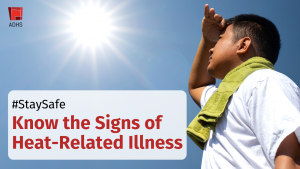 Most Arizonans, especially those who have lived in our beautiful state for more than one summer, already know the precautions when temperatures are extreme, such as drinking plenty of water and protecting yourself from the sun.
Most Arizonans, especially those who have lived in our beautiful state for more than one summer, already know the precautions when temperatures are extreme, such as drinking plenty of water and protecting yourself from the sun.
Knowing all of that, anyone who ventures outside at this time of the year still faces the risk of heat-related illness if the body loses its heat balance. That’s why it’s so important to recognize the signs of heat exhaustion as well as heat stroke, which can be deadly.
Our body temperature needs to be maintained within a narrow range so it can function properly. When the body cannot remove excess heat and properly cool, you’re at risk of heat-related illness.
One of the early signs that your body has lost this balance is heat cramps. The mildest form of heat-related illness, these are painful muscular spasms due to the loss of water and salt from sweating. They usually involve the abdominal muscles or the legs.
If you have heat cramps, take action such as stopping physical activity, going inside, and hydrating so you can halt the progression of heat-related illness.
Heat exhaustion happens when your body overheats and cannot cool itself properly. Signals include cool, moist, pale, flushed, or red skin; heavy sweating; headache; nausea or vomiting; dizziness; and exhaustion. Heat exhaustion often occurs when people exercise heavily or work outside, especially in warm, humid places, sweat heavily, and become dehydrated. Fluid loss causes blood flow to decrease in the vital organs, resulting in a form of shock.
The response to heat exhaustion is much the same as heat cramps, though you may also benefit from using wet cloths or taking a cool bath. Seek medical attention if you are throwing up or if symptoms persist or someone else with symptoms of heat exhaustion refuses water or loses consciousness.
The most dangerous heat-related illness is heat stroke, sometimes known as sunstroke. Your body’s temperature control system, which produces sweating to cool the body, stops working. Signals include hot, red and dry skin; changes in consciousness; rapid, weak pulse; and rapid, shallow breathing. Your body temperature can reach 105 degrees.
Heat stroke is a medical emergency, so call 911 immediately if you have symptoms or you see someone else with symptoms. Move the person to a cooler place. Quickly cool the body using any means available, including cool water and ice.
Since not everyone has quick access to air conditioning and cold water, the Maricopa Association of Governments and Pima County offer cooling centers and hydration stations that can help vulnerable people avoid heat-related illness. Both offer maps showing where these are located.
Before beginning an outdoor activity when temperatures are extreme, take a moment to review signs and treatments for heat-related illness to keep your fun in the sun safe.










